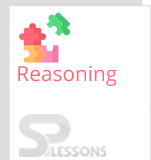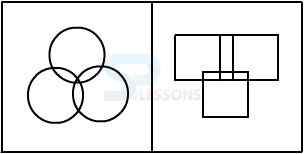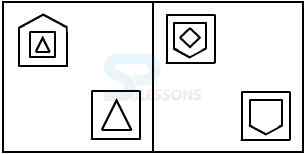 Introduction
Introduction
Classification deals with choosing of "Odd-Man-Out" type alternatives or alternatives behaving in a similar manner to the original series/analogy. Non Verbal Classification is similar to Non Verbal Series where a set of figures are given, such that all, except one have similar features/characteristics/highlights or the one alternative that does not blend with the given series. Test Takers have to select the alternative/option which varies from all different figures in the given set.
Non Verbal Classification - Types of Analogy:-
1. Choosing the odd figure.
2. Choosing a similar figure.
3. Finding figures with the same characteristics.
Choosing one element that is different from others (odd man out): In such kind of problems, an arrangement of five/four figures are given, out of which all aside from one are alike in some way. Select the only distinctive figure in the given set.
Choosing a similar figure: Classification problems in this type, include four un-numbered figures took after by five different figures. The four un-numbered figures shaping the problem set are similar in a specific way. A figure from amongst the numbered figures framing the answer set, is to be picked such that it is like the problems figures in that way.
Finding figures with the same characteristics: This kind of questions contain two un-numbered figures framing the problem set took after by five different figures shaping the answer set. the problem figure have some basic features. Choose the figure from the answer set which likewise shows the same qualities (or to choose the figure which does not display these features from amongst the answer figures, rest of which would show those features).
Reasoning Ability -BANKING|SSC|RAILWAYS|INSURANCE|RECRUITMENT EXAMS – EBOOKS
 Concepts
Concepts
 Models
Models
Model 1: Out of five figures marked A, B, C, D and E, four are similar in a certain manner. However, one figure is not like the other four. Choose the figure which is different from the rest. (S.S.C. 2002)
Solution:
In each of the figures, except figure C, one half of the figure has horizontal shading. Therefore, figure C is the answer which is different from the rest.
Model 2: Out of five figures marked A, B, C, D and E, four are similar in a certain manner. However, one figure is not like the other four. Choose the figure which is different from the rest. (Navodaya Vidyalaya 2005)
Solution:
From the given figure, It is clear that the two dots lie on the same side of diagonal only in figure D. Hence, the figure D which is different from the rest.
Model 3: Out of five figures marked A, B, C, D and E, four are similar in a certain manner. However, one figure is not like the other four. Choose the figure which is different from the rest. (Bank P.O. 2004)
Solution:
Each one of the figures except figure B, contains - one complete square, one cup-shaped element having three sides, one 'L'-shaped element having two sides and one straight line.
Therefore, the figure B is different from the rest.
Model 4: Out of five figures marked A, B, C, D and E, four are similar in a certain manner. However, one figure is not like the other four. Choose the figure which is different from the rest. (Bank P.O. 2005)
Solution:
Except in figure D, all other figures, each element is obtained by rotating the adjacent element through 180 degrees. Therefore, figure D is different from the rest.
Model 5: Out of five figures marked A, B, C, D and E, four are similar in a certain manner. However, one figure is not like the other four. Choose the figure which is different from the rest. (S.S.C. 2004)
Solution:
Except figure A, all other figures can be rotated into each other.
Therefore, figure which is different from rest of them is A.
Model 6: Choose the figure from the amongst the answer figures which does not possess the same characteristics as the two problem figures. (S.B.I.P.O. 2002)
PROBLEM FIGURES:-
ANSWER FIGURES:-
Solution:
Except in figure B, in each one of the remaining answer figures , the numbers of the different types of elements are in sequence. This is a feature which is also exhibited by the two problem figures. Since figure B does not possess this feature, so figure B is answer.
Model 7: Choose the figure from the amongst the answer figures (numbered A, B, C, D and E) which possess the same characteristics as the two problem figures. (Bank P.O. 2004)
PROBLEM FIGURES:-
ANSWER FIGURES:-
Solution:
By observing the given problem figures, it is clear that, three similar elements intersect each other. Similarly, in figure C from the answer set, three similar elements intersect each other. Therefore, figure C possess the same characteristics as the two problems.
Model 8: Choose the figure from the amongst the answer figures (numbered A, B, C, D and E) which possess the same characteristics as the two problem figures. (S.B.I.P.O. 2002)
PROBLEM FIGURES:-
ANSWER FIGURES:-
Solution:
Two elements lying in a pair of diagonally opposite corners are similar. One of the remaining two corner elements is similar to the central element. Therefore, figure B from the answer set is the correct answer which posses the same features as the two problem figures.
Model 9: There are two problem figures (un-numbered figures) followed by five answer figures (numbered as A, B, C, D and E). There are certain common features between the two problem figures. Select a figure from amongst the answer figures which does not show similar features as shown by the problem figures. (Bank P.O. 2004)
PROBLEM FIGURES:-
ANSWER FIGURES:-
Solution:
The figure is open and must consist of an even number of line segments.
Therefore, figure which does not show similar features as shown by the problem figures is B.
Model 10: There are two problem figures (un-numbered figures) followed by five answer figures (numbered as A, B, C, D and E). There are certain common features between the two problem figures. Select a figure from amongst the answer figures which does not show similar features as shown by the problem figures. (Bank P.O. 2004)
PROBLEM FIGURES:-
ANSWER FIGURES:-
Solution:
One of the elements from the upper figure is lost and the remaining figure is reduced in size to form the lower figure. Therefore, figure which does not show similar features as shown by the problem figures is D.


















